The Parenteral Nutrition Market is estimated to be valued at USD 6.9 billion in 2025 and is projected to reach USD 12.9 billion by 2035, registering a compound annual growth rate (CAGR) of 6.5% over the forecast period.
The Parenteral Nutrition market is experiencing consistent growth driven by the rising prevalence of chronic diseases, increasing incidences of malnutrition, and a growing number of patients requiring long-term hospitalization. The future outlook for this market is being shaped by advancements in nutrient formulation, sterile compounding technologies, and the increasing demand for personalized nutrition solutions in clinical settings.
Hospitals and healthcare providers are increasingly adopting parenteral nutrition as a critical therapeutic intervention to manage patients unable to consume food orally or through enteral feeding. Continuous improvements in lipid emulsions, amino acid formulations, and trace elements have enhanced the safety and efficacy of parenteral nutrition therapies.
Additionally, rising healthcare expenditure, better awareness regarding nutritional support in critical care, and a shift towards home-based parenteral nutrition are further supporting market expansion As healthcare systems worldwide focus on improving recovery outcomes and patient survival rates, the Parenteral Nutrition market is expected to continue its steady upward trajectory.
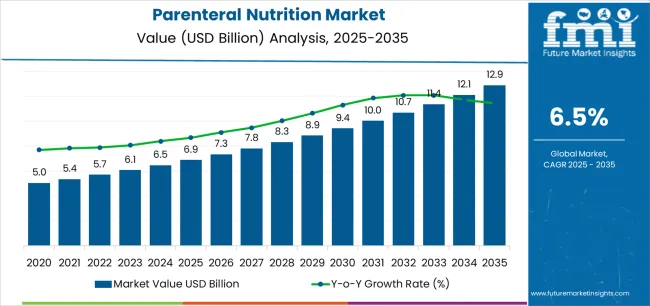
| Metric | Value |
|---|---|
| Parenteral Nutrition Market Estimated Value in (2025 E) | USD 6.9 billion |
| Parenteral Nutrition Market Forecast Value in (2035 F) | USD 12.9 billion |
| Forecast CAGR (2025 to 2035) | 6.5% |
The market is segmented by Nutrient Type, Consumer Type, Route of Delivery, Sales Channel, and Indication and region. By Nutrient Type, the market is divided into Carbohydrates, Lipids, Additives, and Single-Dose Amino Acids. In terms of Consumer Type, the market is classified into Adults, Pediatrics, and Geriatrics. Based on Route of Delivery, the market is segmented into Total Parenteral Nutrition (TPN) and Peripheral Parenteral Nutrition (PPN). By Sales Channel, the market is divided into Institutional Sales and Retail Sales. By Indication, the market is segmented into Cancer Care, Neurological Diseases, GI Disorders, Malnutrition, Alzheimer’s, Chronic Kidney Diseases, Dysphagia, and Others. Regionally, the market is classified into North America, Latin America, Western Europe, Eastern Europe, Balkan & Baltic Countries, Russia & Belarus, Central Asia, East Asia, South Asia & Pacific, and the Middle East & Africa.
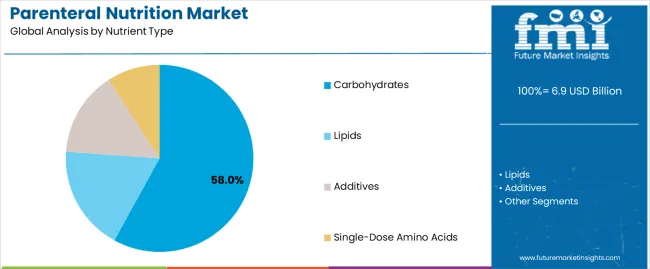
The carbohydrates segment is projected to hold 58.00% of the Parenteral Nutrition market revenue share in 2025, establishing it as the leading nutrient type segment. The dominance of this segment can be attributed to the critical role of carbohydrates as a primary energy source in parenteral nutrition formulations.
Carbohydrates such as dextrose serve as the main substrate for energy metabolism, ensuring stable blood glucose levels and adequate caloric intake in patients receiving intravenous nutrition. The segment has gained prominence due to increasing clinical adoption for managing metabolic requirements in patients undergoing surgery, trauma recovery, or critical illness.
Advancements in glucose stabilization techniques and the development of high-concentration carbohydrate solutions have improved the efficiency of intravenous administration The widespread use of carbohydrates in both adult and pediatric formulations has reinforced their dominance, as they form the base component of total parenteral nutrition regimens essential for patient recovery and metabolic balance.
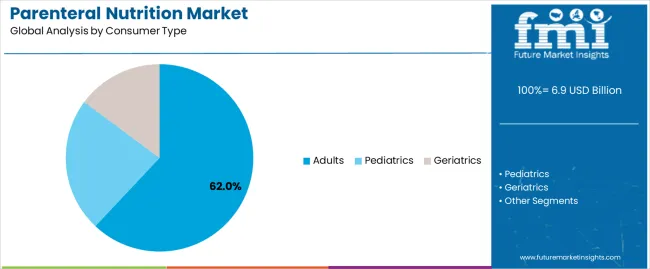
The adults segment is expected to capture 62.00% of the Parenteral Nutrition market revenue share in 2025, making it the largest consumer type segment. This growth has been influenced by the rising incidence of chronic diseases, cancer-related malnutrition, and gastrointestinal disorders among adult patients. The demand for parenteral nutrition in adults has increased as healthcare providers emphasize early nutritional intervention to enhance treatment outcomes and reduce hospital stays.
Adults represent the major patient demographic requiring customized nutrition support due to metabolic demands and comorbidity complexities. Growing awareness among clinicians regarding the benefits of parenteral nutrition in improving recovery rates and maintaining muscle mass during prolonged illness has further boosted the adoption rate.
The expansion of intensive care units and the rising number of surgical procedures have also contributed to segment growth As healthcare institutions increasingly prioritize nutritional support in adult patient management, the adults segment continues to dominate market share.
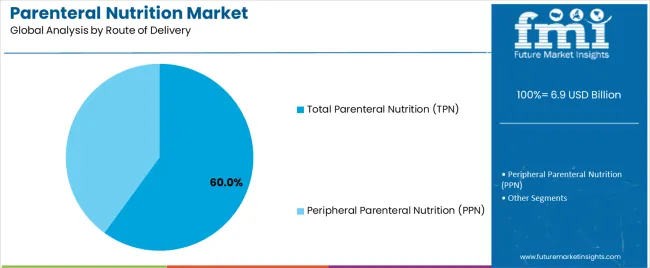
The total parenteral nutrition (TPN) segment is anticipated to account for 60.00% of the Parenteral Nutrition market revenue in 2025, maintaining its leading position among delivery routes. This dominance has been driven by the comprehensive nature of TPN, which provides complete nutritional support to patients who cannot tolerate enteral feeding.
The segment’s growth has been supported by the increasing number of patients with severe gastrointestinal dysfunction, post-surgical complications, and critical illnesses requiring long-term intravenous nutrition. The use of TPN has become integral in hospital and home-care settings, where it ensures balanced delivery of macronutrients and micronutrients essential for patient survival.
Technological advancements in infusion pumps, sterile packaging, and compounding systems have improved safety and administration efficiency Moreover, the rising adoption of home-based TPN programs and personalized formulations tailored to patient-specific metabolic needs have further accelerated the segment’s expansion, securing its dominance in the overall parenteral nutrition market.
The below table presents a comparative assessment of the variation in CAGR over six months for the base year (2025) and current year (2025) for the global parenteral nutrition market. This analysis reveals crucial shifts in performance and indicates revenue realization patterns, thus providing stakeholders with a better vision of the growth trajectory over the year. The first half of the year, or H1, spans from January to June. The second half, H2, includes the months from July to December.
| Particular | Value CAGR |
|---|---|
| H1 | 5.5% (2025 to 2035) |
| H2 | 5.7% (2025 to 2035) |
| H1 | 6.2% (2025 to 2035) |
| H2 | 6.8% (2025 to 2035) |
In the first half (H1) of the decade from 2025 to 2035, the business is predicted to surge at a CAGR of 5.5 %, followed by a slightly higher growth rate of 5.7 % in the second half (H2) of the same decade. Moving into the subsequent period, from H1 2025 to H2 2035, the CAGR is projected to increase slightly to 6.2 % in the first half and remain moderate at 6.8 % in the second half. In the first half (H1) the sector witnessed an increase of 50 BPS while in the second half (H2), the business witnessed a decrease of 20 BPS.
Enhancement with Technological Advancements in Delivery Systems
Delivery systems for parenteral nutrition are being significantly improved by technological advancements. Some companies are developing sophisticated infusion pumps and catheters, which minimize the risk of infection and complications. For instance, B. Braun has launched smart infusion systems that come with built-in safety measures as well as real-time monitoring features.
Moreover, these can indicate to healthcare providers the onset of troubles such as blockages or air bubbles hence leading to immediate treatments. Furthermore, there is an emphasis on manufacturing user-friendly designs that make ease of administration a reality. Baxter International’s Sigma Spectrum infusion pump for instance has been designed with user-friendly controls thus enabling healthcare givers to deliver accurate nutrition doses easily.
Empowering Patients with Home-Based Methods
The provision of care-at-home is changing patient management by saving resources and time while still improving the quality of life for patients. This has LED to the need for long-term nutritional support for chronically ill patients, therefore pushing this trend further ahead. Brands design portable easy-to-use equipment so that patients can independently manage their nutritional needs from anywhere within their homes.
For example, Baxter International’s Home Choice Pro is a portable device used at home by patients who require parenteral nutrition. These gadgets possess safety features that guarantee uninterrupted accuracy on nutrition provision to patients alongside instant notification about anything going wrong.
Additionally, manufacturers provide extensive education and care to assist parents in making good decisions concerning home-based therapy thereby raising confidence levels among guardians. This model not only reduces hospital visits but also cuts medical costs hence offering convenience and ease to the patient.
Integration of Digital Health Technologies
Digital health technologies integration into parenteral nutrition is transforming care delivery and treatment efficiency. Companies are utilizing telemedicine, remote monitoring, and data analysis to provide holistic care for patients. For instance, Nestlé Health Science has developed digital platforms that enable real-time monitoring of patients' nutritional status.
These systems can show healthcare providers a patient’s progress by tracking them from a distance. Moreover, digital health tools enhance the interaction between patients and healthcare providers. This ongoing feedback loop facilitates prompt resolution of any complications as well as optimization of nutritional support. Companies integrating digital health technologies are thereby improving both clinical outcomes and access to care.
Global sales increased at a CAGR of 6.2 % from 2020 to 2025. For the next ten years (2025 to 2035), projections are that expenditure will rise at 6.8 % CAGR.
The industry grew considerably between 2020 and 2025. This was because of the rise in chronic diseases such as cancer, gastrointestinal disorders, and diabetes that prompted demand for specialized nutritional support. These patients frequently need parenteral nutrition to maintain their nutritional status when they cannot take food through the mouth or intestines.
Medical technological advancement and better healthcare infrastructure made it easier and safer to use such nutrition products. There were improvements in formulation, packaging, and delivery systems, which increased the efficiency and convenience of such nutrition products for both hospital and home care purposes. These changes resulted in lowered risks and complications; hence more confidence by medical practitioners in the prescription of PN.
In the future from 2025 to 2035, the global sector will continue to move ahead, driven by ongoing advancements as well as emerging trends. One aspect that will make this possible is the increasing number of elderly people globally. Considering that elderly people are prone to malnutrition as well as chronic diseases implies that there is demand for products like PN.
Additionally, since companies are using telemedicine, remote monitoring, and data analytics among other technologies to improve patient care quality and treatment efficiency; therefore, individual patient needs can be met through manufacturing specific formulae containing nutrients, most suitable for them, thus ensuring positive outcomes while at the same time cutting down chances of complications.
Tier 1 refers to the market leaders who have extensive research and development capabilities required to deliver substantial product portfolios and have significant market share. Such companies are responsible for leading innovations in formulation processes, delivery systems, and sustainability aspects. Examples include Baxter International and Fresenius Kabi.
They have a worldwide presence through well-developed distribution channels added with enough resources required for investment in modern technologies. Hence, they enjoy competitive advantages over others because they offer many alternatives depending on the patient’s need. These big sharks hold around 60- 70%of market share.
Tier 2 covers regional players and specialists who either deal with a given segment of the parenteral nutrition sector or concentrate on specific categories. These firms are less popular compared to MNCs, but they are excellent in niche categories or regions.
Examples include B. Braun as well as Grifols. Quite often these organizations have much emphasis on quality aspects and innovations within their respective specializations such as advanced infusion systems, and target patients among others. This is why they quickly adapt to changing business ecosystems or emerging trends, thus maintaining business competitiveness confined to their niches.
Tier 3 features local and emerging enterprises that are newcomers or else operate within a limited scale inside the PN sector. They usually concentrate on serving small regional industries by providing them with cost-effective solutions, which are customized according to the peculiar needs of those.
Although they don’t possess vast resources like larger counterparts do, these companies always give personalized attention and flexibility too. Often, they work together with local healthcare providers in addressing specific nutritional challenges, thereby contributing to the overall variety as well as dynamism that exists within the PN industry.
The following table shows the estimated growth rates of the top three territories. USA and Germany are set to exhibit high consumption, recording CAGRs of 5.4 % and 7.3%, respectively, through 2035.
| Countries | CAGR 2025 to 2035 |
|---|---|
| USA | 5.4% |
| Germany | 7.3% |
| China | 6.2% |
| Japan | 8.5% |
| India | 9.7% |
The business ecosystem in the United States is projected to exhibit a CAGR of 5.4 % during the assessment period. By 2035, revenue from the sales of this sector in the country is expected to reach USD 3,238.8 million.
One major reason is an increase in obesity levels and related metabolic disorders. Obesity has become a common condition requiring special diets alongside, diabetes or cardiovascular diseases, thus increasing the demand for nutrition solutions tailored to such cases. The robust healthcare infrastructure and advanced medical facilities available in the USA is another important factor.
For this reason, there exist well-equipped hospitals and specialized clinics that make sure patients have access to high-quality products. Moreover, research and development contribute highly towards innovations in formulations as well as delivery systems within the USA.
The demand in Germany is calculated to rise at a CAGR of 7.3 % during the forecast period (2025 to 2035). By 2035, Germany is expected to account for 10.0 % of sales in the world.
Germany is a country that is strongly committed to healthcare quality and patient safety. As such, Germany has strict regulatory standards and a well-developed healthcare system focused on delivering high-quality medical care, meaning that all such product supplies meet stringent safety and efficacy criteria making them readily acceptable for use in clinical settings. Moreover, there is a growing emphasis on preventive medicine coupled with early intervention.
German healthcare providers take proactive measures in identifying and combating cases of nutritional deficiencies among their patients, especially those suffering from chronic diseases or going through major surgeries, thereby increasing demand for better parental nutritional strategies. These strategies are also used as prophylactic measures against hospital-acquired infections, hence reducing the incidence rates amongst affected persons over different periods.
Consumption of such nutrition products in Japan is projected to increase at a CAGR of 8.5 % over the next ten years. By 2035, the size is forecasted to reach USD 996.5 million, with Japan expected to account for a share of 8.0 % globally.
One of the main forces behind this is the advanced healthcare technology and infrastructure in the country. Japan is recognized for its state-of-the-art medical innovations and good health standards, which make it easier to use complex nutrition solutions. As a result, there is an increased consumer demand for customers who receive high-quality nutritional care.
Also, Japan’s population is aging at a faster rate, thus significantly impacting the market expansion. This means that there are more elderly people in Japan than anywhere else which results in the need for special nutritional support services when managing age-related health issues. Therefore, this trend raises demand specifically targeted at older individuals.
| Segment | Carbohydrate (By Nutrient Type) |
|---|---|
| Value Share (2025) | 58.0% |
Carbohydrate formulations have evolved in stability and effectiveness, with advancements. The latter encompasses glucose polymers and balanced carbohydrate mixtures as well as a longer longer-lasting energy supply; thus, improved metabolic control decreases complications such as hyperglycemia. These improvements make carbohydrate-based products more appealing to healthcare providers.
Also, the growing prevalence of conditions like sepsis, trauma, and major surgeries that require intensive nutritional support increases the demand for carbohydrate-laden products. Since these diseases are characterized by a need for rapid energy replacement, carbohydrates play a more vital role thereby propelling the growth of the industry.
| Segment | Adults (By Consumer Type) |
|---|---|
| Value Share (2025) | 62.0% |
Several key factors drive up sales of adult nutrition products. There is an increase in chronic ailments (e.g., cancer) affecting adults that call for specific dietary requirements. In many cases, nutrient intake or oral absorption gets affected, making such products essential to maintain health status while promoting recovery. Moreover, new kinds of treatments and procedures have LED to critically ill patients’ better survival chances, hence requiring them to be on PN in their recovery progressions. The result has been a need for specialized solutions that meet adult patients’ unique requirements.
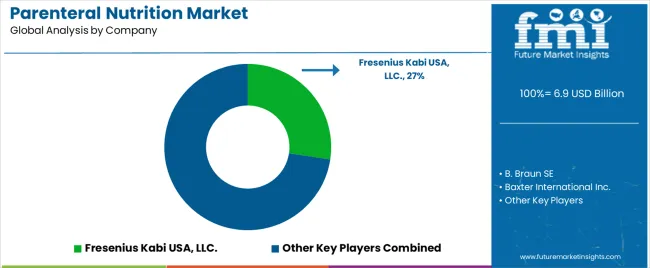
Baxter International, Fresenius Kabi, and B Braun are some of the leading companies that dominate the field supported by their wide range of products and extensive distribution channels globally. These firms concentrate on R&D expenditure to produce innovative product lines that fulfill changing healthcare provider’s needs.
To gain more sales, manufacturers are focusing on strategic partnerships and collaborations. By partnering with hospitals, clinics, and research institutions, they can enhance their market presence and credibility. This also includes clinical trials done with academic institutions aimed at validating new formulations thus promoting product adoption.
For instance
As per nutrient type, the industry has been categorized into Single-dose amino acids (Standard and Disease-Specific), carbohydrates, Lipids, and Additives (Vitamins and minerals, Trace Elements, and Organic Phosphates).
This segment is further categorized into Pediatrics, Adults, and Geriatrics.
As per the route of delivery, the industry has been categorized into Total parenteral nutrition (TPN), and Peripheral parenteral nutrition (PPN).
This segment is further categorized into Institutional Sales (Hospitals, Clinics, Long-Term Care Centres, and Home Care Agencies), and Retail Sales (Retail Pharmacies, Compounding Pharmacies, Online Pharmacies, and Manufacturer Websites).
As per the indication, the industry has been categorized into Neurological Diseases, GI Disorders, Malnutrition, Alzheimer’s, Cancer Care, Chronic Kidney Diseases, Dysphagia, and Others.
Industry analysis has been carried out in key countries of North America, Latin America, Europe, East Asia, South Asia, Oceania, and the Middle East & Africa.
The global parenteral nutrition market is estimated to be valued at USD 6.9 billion in 2025.
The market size for the parenteral nutrition market is projected to reach USD 12.9 billion by 2035.
The parenteral nutrition market is expected to grow at a 6.5% CAGR between 2025 and 2035.
The key product types in parenteral nutrition market are carbohydrates, lipids, additives and single-dose amino acids.
In terms of consumer type, adults segment to command 62.0% share in the parenteral nutrition market in 2025.






Full Research Suite comprises of:
Market outlook & trends analysis
Interviews & case studies
Strategic recommendations
Vendor profiles & capabilities analysis
5-year forecasts
8 regions and 60+ country-level data splits
Market segment data splits
12 months of continuous data updates
DELIVERED AS:
PDF EXCEL ONLINE
Parenteral Packaging Market Size and Share Forecast Outlook 2025 to 2035
Parenteral Formula Market Analysis by Type of Nutrient, Indications and Sale Channels Through 2035
Parenteral Compounding Market Analysis - Share, Size, and Forecast 2025 to 2035
Market Share Breakdown of Parenteral Packaging Industry
Parenteral Drugs Packaging Market
Self-administered Parenteral Market Size and Share Forecast Outlook 2025 to 2035
Nutritional Bars Market Size and Share Forecast Outlook 2025 to 2035
Nutritional Yeast Market Size, Growth, and Forecast for 2025 to 2035
Nutritional Labelling Market Trends and Forecast 2025 to 2035
Nutritional Ingredients in Animal Feed Market Trends - Growth & Industry Forecast 2025 to 2035
Nutritional Lipids Market
Nutrition Therapy Market
Fish Nutrition Market Size, Growth, and Forecast for 2025 to 2035
GLP-1 Nutritional Support Market Analysis - Size, Share, and Forecast Outlook 2025 to 2035
Multi Nutritional Supplement Market Analysis - Size, Share, and Forecast Outlook 2025 to 2035
Infant Nutrition Hydrolysate Ingredients Market Size and Share Forecast Outlook 2025 to 2035
Sports Nutrition Ingredients Market Size and Share Forecast Outlook 2025 to 2035
Animal Nutrition Chemicals Market Analysis - Size, Share, and Forecast Outlook 2025 to 2035
Infant Nutritional Premix Market Size and Share Forecast Outlook 2025 to 2035
Sports Nutrition Market Brief Outlook of Growth Drivers Impacting Consumption

Thank you!
You will receive an email from our Business Development Manager. Please be sure to check your SPAM/JUNK folder too.
Chat With
MaRIA